

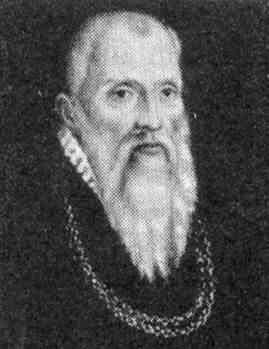
Adrian Willaert
Source: HOASM
Born circa 1490 in Rumbeke, Belgium, Adrian Willaert, of the Franco-Flemish school, was founder of the Venetian school of music during the Renaissance. Intending to study law in Paris, he switched to music and was probably composing by 1510. Some might remember when America issued 'Horse with No Name' in 1971. A lot of people thought that was by Neil Young until learning otherwise, and may yet to this day. The same thing happened to Willaert upon visiting Rome about 1515 where the papal choir was already singing one of his songs, thinking it was by Josquin des Prez. So long as 'Verbum Bonum' was by Josquin things were alright. But upon informing the choir of its error, rather than correcting it they simply sang it no more. 'Verbum Bonum' was published in Book 4 of Petrucci's 'Motetti de la corona' of 1519.
Petrucci's 'Harmonice Musices Odhecaton' of 1501, the first book of polyphonic scores, is a good anchor of the peak Renaissance period already in swing for a decade and getting higher without bounds, particularly as concerns us here, being Petrucci's three-step process with movable type, meaning that copies of scores no longer depended on scribes with quills. Though the books that resulted were hugely expensive, without Petrucci there would been no Tin Pan Alley in which to buy cheap sheet music four centuries later. Petrucci wasn't necessary to the musical Renaissance, long since well on its way without him, but it could not have gone unaffected by Petrucci's entrance onto the musical scene.
As for the 'Verbum Bonum' per 1519, that is yet high Renaissance with perhaps another decade to roar before mannerism in painting begins to trend and new ways of achieving counterpoint become little leaks at the head of a long path shaping toward the baroque. Scholars have a logical reason to place the official end of the Renaissance, at least in Italy, in 1527 when Holy Roman Emperor Charles V (Habsburg) sacked Rome on 6 May, which wasn't supposed to happen because Holy Roman Emperors didn't get elected without Popes and Rome belonged to the Papacy. The whole point of Holy Roman Emperors was to keep Europe north of the Alps agreeably in line with the Papacy, not imprison the Pope. Willaert's Venice along with France, et al, were allies to the Papacy during these events. As Holy Roman Emperors were (almost) always German kings, the animosity between Habsburgs and the Papacy added fuel to the Protestant Reformation of Martin Luther since 1517 ('Ninety-Five Theses') at least a couple years after Willaert composed his Catholic supplication to the Virgin Mother, 'Verbum Bonum'.
'Verbum bonum et suave' Marian motet intended a 4 Adrian Willaert
'Word good and sweet'
Comp: < 1515 Pub: Petrucci’s 'Motetti de la corona' Liver 4 1519
La Chapelle des Chantres des Ducs de Lorraine
Willaert, who yet had no reputation like Josquin's, nevertheless entered into the service of Cardinal Ippolito I d'Este of Ferrara in 1515. Upon the cardinal's death in September of 1520 Willaert entered into the service of Duke Alfonso II d'este of Ferrara until 1525, at which time he went to Milan to work for Ippolito II d'Este, who would become Cardinal in 1538. Among Willeart's associates while employed by Duke Alfonso II d'este in Ferrara was Jachet de Mantua who entered into the service of Alfonso in 1525. Jachet was a major composer of the period who would be a lifelong rival to Willaert, albeit from Mantua since 1526, thus the name he is known by, for he was actually French, born in Vitre in 1483. Jachet would enter into the service of the Church in Mantua and there remain until his death in October of 1569. In the time that Jachet and Willaert knew one another they collaborated on a few Vesper Psalms for double alternating choirs, Jachet choir 1, Willaert choir 2. These were 'Dixit Dominus' for eight voices (two choirs of four), 'Laetatus sum' for four voices (two "choirs" of two) and 'Nisi Dominus'' for four voices. These saw publishing along with other titles by Jachet and Willaert in 'Psalmi vesperales' of 1550.
'Dixit Dominus' Vespers Psalm a 8 for double alternating choirs
Choir 1 Jachet Chori 2 Willaert
Circa 1525-26 Pub: 'Psalmi vesperales' 1550
Collegium Vocale / Euterpe Ensemble directed by Antonio Eros Negri
The House of Este had been one of the more powerful in Europe. Its elder German line is called the House of Guelph (Welf) beginning with Welf I, Duke of Bavaria in 1070 and running through dukes of Saxony, Brunswick and Luneberg. This line would continue to the Electors of Hanover (Holy Roman Empire with its rulers elected by the Pope and other select powers), the Hanover monarchs of Great Britain and the current Prince of Hanover and head of the House of Guelph, Ernst August (b 1954), whose little brother is Prince Heinrich Julius Günter (b 1961), author and founder of MatrixMedia Verlag. The younger Italian House d'Este which concerns Willaert didn't fare so well. This branch was established south of the Alps when Obizzo II d'Este acquired Ferrara in 1264, Modena in 1288 and Reggio in 1289. Ferrara became a fief of Pope John XXII in 1332 and the Estes his representative vicars thereafter. Over the next couple centuries the Italian Este family became rich enough to become major patrons of the Renaissance. This branch rode high in Europe's saddle until the death of Alfonso II d'Este in 1597. Leaving no heirs, his lands were annexed by the Church the next year and the Italian House of Este drew to a close.
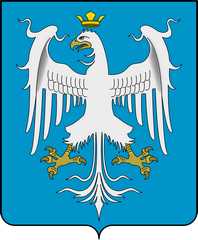
Italian Este Coat of Arms since 1239
Source: Wikipedia
Willaert had been a youth during the heydays of Venetian painters, Giovanni Bellini, Gentile Bellini and Giorgione. His own lifelong contemporary was the painter, Titian, possibly born in 1489 only a year before Willaert. By Titian's time Venetian painter, Antonello da Messina, had introduced oils to Venice as a medium for paints circa 1470, probably taught to him in Naples by Niccolò Colantonio who had been using oils since the forties. Oil had been used as a binder for paints for several centuries as an alternative to fresco, which binds to wet lime plaster, or egg tempera. But the "father" of oil painting in Europe is generally considered to be Jan Van Eyck of Netherlands who was painting masterpieces in oils in the early 1430s. It took another forty-odd years for oil painting to arrive and stick to Venice via Messina.
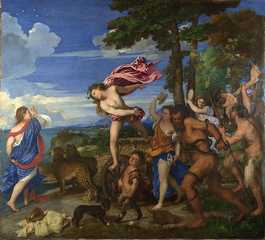
Bacchus and Ariadne Oil Titian c 1520–1523
Source: Wikipedia
It was in 1527 that Willaert became maestro di cappella (choirmaster) of St. Mark's in Venice, a post he retained until his death. The Republic of Venice had been formed in 697, Paolo Lucio Anafesto its first Doge ("Duke"). By Willaert's time it was a major maritime power with territories stretching as far as Crete and Cyprus along the southwestern seaboard of the Ottoman Empire. St. Mark's Basilica had begun construction in 828. By the time of the Renaissance Venetian architecture was among the major features of Europe.
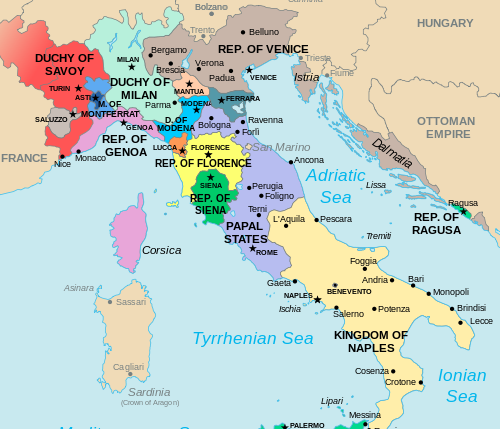
Italy circa 1500 High Renaissance Willaert about age 10
Source: Pinterest
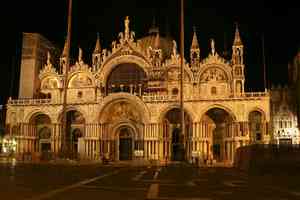
St. Mark's Basilica
Source: Best Tourism
Willaert developed a reputation as choirmaster at St. Mark's such that composers throughout Europe went to Venice to study under him, hence the Venetian School. Willaert is associated at least in part for the development of multiple new shapes of music such as the canzone (secular polyphonic song resembling a madrigal) and the ricercar(e) (early form of fugue). It was the architectonics of the San Marco Basilica by which he became known for cori spezzati or, separated choirs. St. Mark's had two choir balconies widely spaced with an organ in the middle. Willaert composed for stereo, so to speak, while accounting for cathedral echo in a deep hall. Writing for divided choirs, which goes by the term, polychorality, wasn't original with either Willaert or Jachet, but Willaert put his name on it with dialectical works for St. Mark's. It isn't known when Willaert wrote 'Lauda Jerusalem', only that it was no earlier than his arrival to St. Mark's in 1527 and no later than its publishing in Antonio Gardano's 1550 'I salmi appertinenti alli vesperi per tutte le feste dell'anno' containing seven more antiphons (texts from Psalms) intended for eight voices. Among numerous chansons set to French lyrics was 'Dessus le marché d'Arras', which may well have been composed earlier than 'Lauda Jerusalem' as it was published twenty years earlier in Pierre Attaingnant's 1530 'Six Gaillardes et six Pavanes avec Treze chansons musicales a quatre parties'. Adrian also wrote multiple motets for the Office of Matins on Christmas Day. 'O Magnum Mysterium' saw print in 1539 in 'Motetti di Adrian Willaert a quattro voci Libro secondo' published jointly by Andrea Antico, Brandino and Ottaviano Scotto.
'Lauda Jerusalem' Salmi spezzati for Vespers by Adrian Willaert
Psalm 147 for split choir sometime 1527-50 Pub Venice 1550
Currende Choir / Concerto Palatino Ensemble directed by Erik van Nevele
Organ: Herman Stinders Trombone: Wim Becu
'Dessus le marché d'Arras' French chanson by Adrian Willaert
'At the marketplace in Arras'
Pub Paris 1530
Romanesque directed by Philippe Malfeyt
'O Magnum Mysterium' Motet for Christmas Day by Adrian Willaert
Pub Venice 1539
Cappella Marciana directed by Marco Gemmani
Willaert is probably most greatly regarded for his contributions to the madrigal, a form of polyphonic song that became highly popular in the 16th century due much to Willaert, and which would develop toward baroque at the end of the century. Willaert's initial madrigals were published in Gerolamo Scotto's 'Il secondo libro de madrigali' in 1536 including 'Amor mi fa morire', 'Signora dolce io te vorrei parlare', 'Quando gionse per gli occhi al cor', 'Madonna il bel desire che m'accendest'in' and 'Grata e benigna donna ch'in premi'al mio servir'. This volume by Scotto is otherwise largely dedicated to works by Philippe Verdelot.
Born circa 1480-85 in France, Verdelot early headed south to Italy where he worked in various locations including Venice, in the meantime becoming the originator of the madrigal sometime between 1518 when Niccolò Machiavelli wrote 'La Mandragola' ('The Mandrake') and 1526 when that play of five acts premiered in Florence in 1526. The several canzone that Verdelot contributed to that production are the earliest-known madrigals, the audience to hear them probably little mindful that the trend they were igniting would replace the frottola and make the madrigal the most popular form of music in Italy for several decades into the 17th century. But Verdelot wouldn't live to see most of that happen, perhaps dying in battle, perhaps by plague or otherwise, sometime between 1530 and 1540.
Another popular style to which Willaert put some industry was the Neapolitan villanella popular among the peasantry of Naples, and by which he parodied madrigals. The villanella wasn't a folk music with obscure crude in a deep past, but a pop form of recent origin which caught on well with the common people (peasants) of Naples. Willaert's madrigals were showcase works on which he lightened up via villanelle. 'O Bene Mio' is a madrigal in villanella style written circa 1540 toward publishing in Girolamo Scotto's 1542 'Madrigali a quatro voce Libro primo' followed by 'Canzone Villanesche alla Napolitana' in 1545.
'O Bene Mio' Villanella-styled madrigal by Adrian Willaert
Circa 1540 Pub Venice 1542/45
Chamber Choir of Europe directed by Nicol Matt
The madrigal gradually replaced the frottola as a secular Italian song with a little assistance from Pietro Bembo, an author and editor of some prestige who pointed to Petrarch (1304-74) as the ideal (and became a cardinal in 1538). Willaert's was something of the same opinion, setting multiple sonnets from Petrarch's 'Canzoniere' to madrigals. No fewer than 24 of them were published in Antonio Gardano's 'Musica Nova' in 1559 along with Panfilo Sasso's 'Quando Nascesti Amor'. Gardano and Gerolamo Scotto ran the two major music publishing outfits in Venice at the time.
'Io amai sempre' Madrigal setting for Petrarch by Adrian Willaert
'I've always loved'
Circa 1540 #1 of Madrigals in 'Musica Nova' of 1559
Ensemble: Singer Pur
'Amor, Fortuna' Madrigal setting for Petrarch by Adrian Willaert
Circa 1540 #2 of Madrigals in 'Musica Nova' of 1559
Ensemble: Singer Pur
'Quando Nascesti, Amor?' Madrigal setting for Sasso by Adrian Willaert
Circa 1540 #22 of Madrigals in 'Musica Nova' of 1559
Included in the S-Sk Holm. S 229:1 partbook compiled in Stockholm 1560-70
Bakfark Bálint Lute Trio / The Chamber Chorus Of The Liszt Ferenc Academy Of Music 1981
'Missa Christus Resurgens' is a parody (imitative) Mass of Jean Richafort's motet, 'Christus resurgens'. This work was added to the Piacenza Discantus s.s. (1) manuscript compiled between 1540 and 1560. It also saw transcription into the F-CA MS 125 made in Bruges, Belgium, in 1542.
Sanctus & Benedictus of 'Missa Christus Resurgens' by Adrian Willaert
Published in manuscript 1542
Choir of St. Ignatius Antioch Episcopal Church NYC
Willaert also addressed the frottola which had been the predominant popular form in Italy since at least the 1470s, but which the madrigal would replace in Willaert's lifetime. Both frottole below were published in 'Canzone villanesche alla napolitana' in 1545 containing 15 villanelle by Willaert. Bringing up the rear of this excursion into Willaert's world is a mature ricercar, being Recercar Decimo published in Gardano's 1551 'Fantasie Recercari: Contrapunti a tre voci Libro 1'.
'Vecchie letrose, non valete niente' Villanella-styled frottola a 4 by Adrian Willaert
'Spiteful old hags, you are good for nothing'
#5 of 'Canzone villanesche alla napolitana' of 1545
La Capella Reial De Catalunya / Hespèrion XXI directed by Jordi Savall
'Madonna mia famme bon offerta' Villanella-styled frottola a 4 by Adrian Willaert
'My Madonna, make me an offer'
#6 of 'Canzone villanesche alla napolitana' of 1545
Quartet from The St. Olaf Early Music Singers St. Olaf College 2012
'Recercar Decimo' Ricercar intended a 3 by Adrian Willaert
Published in 'Fantasie Recercari' of 1551
David Hatcher on unspecified strings
Willaert left behind 8 to 10 masses, above 50 hymns and psalms, more than 150 motets, some 60 French chansons, above 70 madrigals and 17 ricercars. By the time of his passing on 7 December of 1562 Willaert had helped transform Venice from a musical backwater into one of the major centers of European music to follow the Renaissance. Titian lived to a "riper" old age of about 86 years, not to die in Venice until 27 August 1576.
Further Sources & References for Adrian Willaert:
Martha Feldman (City Culture and the Madrigal at Venice / University of California Press 1995)
Benjamin Ory (The Imitation Generation / 2021)
VF History (notes)
Audio of Willaert: Classical Archives
Compositions by Willaert: Corpus:
Adrian Willaert Foundation (chronological per MSS)
Opera Omnia (CMM Editions)
University of California Press (madrigals)
Compositions by Willaert: Individual (herein mentioned):
Amor, Fortuna (madrigal setting of Petrarch / comp c 1440 / pub 'Musica Nova' 1559):
Io amai sempre (madrigal setting of Petrarch / comp c 1440 / pub 'Musica Nova' 1559)
Lauda Jerusalem (Peter Lawson / Ritual, Myth and Humanism in the Origins of the Venetian Style / 2015)
Missa Christus Resurgens (pub 1542): Jeremy Summerly (alt)
O Bene Mio (madrigal / comp c 1540 / pub 1542/45):
Madonna mia famme bon'offerta (Villanella-styled frottola pub 1545)
O Magnum Mysterium (motet for Christmas Day Office of Matins / pub 1539)
Quando Nascesti, Amor? (madrigal setting of Petrarch / comp c 1440 / pub 'Musica Nova' 1559)
Vecchie Letrose (Villanella-styled frottola pub 1545)
Verbum Bonum et suave (motet / comp < 1515 / pub 1519):
Antonio Gardano (Venetian publisher 1509-69):
Jachet de Mantua (composer 1483-1559):
Compositions (CMM Editions)
Grove's Dictionary of Music and Musicians (1922)
Authority Search: BnF VIAF World Cat
Musical Forms / Styles:
The Antiphon (chants from Psalms)
Cori spezzati (split choir):
Valerio Morucci (Reassessing the Development of cori spezzati / Early Music / 2021)
Polychorality:
Iakos Demetriou (The Venetian Music School (1550-1610))
Bartłomiej Gembicki (The Memory of Meaning: Polychorality in Venice and the Cori Spezzati Meme / 2020)
Masataka Yoshioka (Singing the Republic: Polychoral Culture at San Marco in Venice (1550-1615) / U of North Texas / 2010)
The Ricercar:
Classical Music Guide Google Groups Wikipedia
The Sonnet (poetry):
Martha Feldman (City Culture and the Madrigal at Venice / University of California 1995)
Publications:
Bonnie Blackburn (Index
of MSS
& RISM)
Canzone villanesca alla napolitana (1545):
Fantasie recercari
et contrapunti a tre voci (Gardano
/ Venice 1551):
Impressions (Libro
Primo)
Gaspari (various)
Hymnorum Musica (Scotto / 1550)
I-PCd s.s. (1) [Discantus] (MSS partbook / Piacenza 1540-60):
I salmi appertinenti alli vesperi per tutte le feste dell'anno (Gardano / Venice 1550):
Mary S. Lewis (various)
Madrigali a quatro voce libro primo (Scotto / 1542)
Motetti di Adrian Willaert Libro secondo a quattro voci (Antico / Brandino / Scotto / 1539):
Motetti de la corona (Ottaviano Petrucci / Vol 1-4 1514/1519):
Impressions (Liber 4 containing 'Verbum Bonum')
Liber 4 ('Verbum
Bonum' / the only Willaert title in these books)
Musica
Nova (Gardano / Venice 1559):
Singer Pur Program Notes (2009)
Six
Gaillardes et six Pavanes avec Treze chansons musicales a quatre parties (Attaingnant /
Paris 1530):
Winchester Partbooks (MSS
1564-66)
Recordings of Willaert: Catalogs:
Discogs
HOASM
Music Brainz
Presto
Recordings of Willaert: Select:
Chansons | Madrigali | Villanelle (Romanesque directed by Philippe Malfeyt / Ricercar RIC 331 / 1994)
(Missa Christus resurgens (Oxford Camerata directed by Jeremy
Summerly / Naxos / 1998)
All Music
Chandos
Mozaart
Naxos
jpc
O Magnum Mysterium
(Mignarda 2016)
Scores / Sheet Music:
Madonna mia famme bon'offerta (motet for Christmas Day Office of Matins / pub 1539)
O Magnum Mysterium (motet for Christmas Day Office of Matins / pub 1539)
Gerolamo Scotto (Venetian publisher c 1505-72):
The Venetian School: Ian Coulling
Further Reading:
Anthony Carver (Cori Spezzati / Cambridge University Press 1988)
Janelle Davis (A Case Of Mistaken Identity 2014)
Bibliography:
David Bryant (13 Cori Spezzati in Composition and Sound / 2018)
Donna G. Cardamone (The canzone villanesca alla napolitana / Routledge 2008)
Michele Fromson (Themes of Exile in Willaert's 'Musica nova' / Journal of the AMS 1994)
David Kidger (Willaert and Gabrieli secular music / Early Music Vol 32 No.3 / 2004)
Mary S. Lewis (Antonio Gardano, Venetian Music Printer Vol 2 of 3 / Routledge / 2005)
Authority Search: BnF VIAF World Cat
Other Profiles:
Classical Main Menu Modern Recording
|
|
hmrproject (at) aol (dot) com